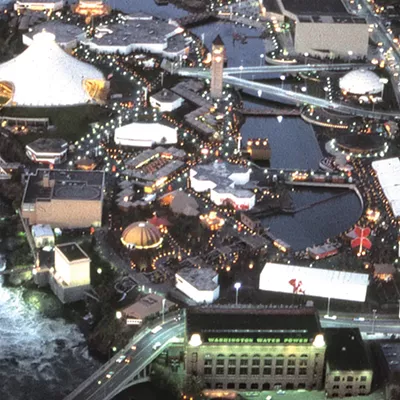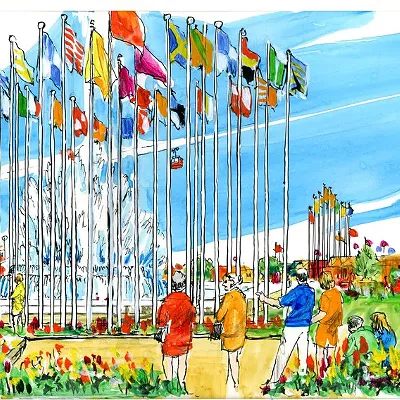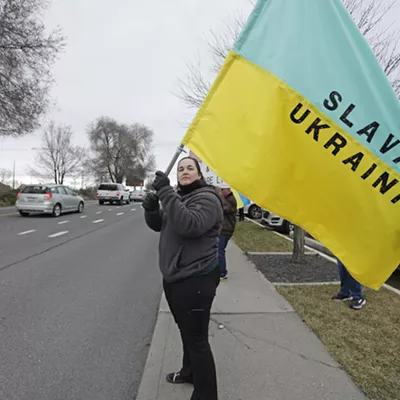Because, in fact, if it weren't for that bejeweled borderline drag queen, Spokane might not have an Opera House or, for that matter, might never have hosted Expo '74. While the event might seem like a tattered relic of ancient history to most of us, it played a very important part in reviving Spokane when the city was nearly flat-lining.
For those of you who might not have been around for those six months when Spokane was the center of the global arts scene, hosting that World's Fair meant big things for this little Eastern Washington town. In fact, it could be argued that it was that event that kept this town ticking.
Long before '74, the downtown core was completely occupied by railroad yards. The area along Spokane Falls Boulevard was rife with problems — from heavy prostitution to large populations of homeless people. Concerned business leaders formed a group called Spokane Unlimited in 1959, intending to find ways to improve the downtown core. People became interested and a group of community members spun off into the Association for a Better Community. ABC focused on relocating the railroads from the downtown core to a less central location and, when that was achieved, throwing a huge celebration to celebrate the revitalization of the city.
"The board of directors (of Expo), specifically Jim Cowles, sat down in (the railroad's) offices and said, 'you've got to move now,'" Mike Kobluk, the former director of performing and visual arts for the World's Fair, says. "If the railroads hadn't moved, there would have been no World's Fair."
Getting railroads to actually pick up and move was not exactly an easy task. But neither was making an Opera House and Expo Center in a no-name Northwest town like Spokane, Wash., an easy sell on the biggest entertainers and countries of the world. And Kobluk started trying to book the Opera House stage for Expo two years in advance.
"It was a hard sell at first," he says, "but once those initial acts signed, now we had something to talk about with the Bob Hopes and others."
Getting those initial acts were tough — that was, until less than year before the grand opening ceremonies of Expo '74, Kobluk received an envelope with a contract for six performances by none other than Liberace, who signed himself in grandiose, loopy cursive letters. After two years of having little more than high school bands and community theater groups, Kobluk could finally believe that the World's Fair would happen.
"We are going to be the entertainment capital of the world," Kobluk recalls of an excerpt from a local newspaper article previewing the event. "And I think we were," he says.
Right now, we're standing amid sheets of Debussy and Korngold music - Kobluk and myself - somewhere between the string and woodwind sections, where white lights are shining brightly down on the chair- and music stand-littered Opera House stage. The house is silent except for Kobluk who is recounting stories about the performances of Expo acts from the Georgian State Dancers to international ballet troupes, from Bob Hope and Bill Cosby. He pauses and smiles as he looks out into the crowd of empty crimson seats. All of that history - fighting for an opera house to be built, begging acts to come to Spokane's fair and finally corralling 5 million visitors through the Expo grounds - that will turn age 30 next Wednesday.
"I think the Opera House changed the arts scene forever. Until then, groups like the Symphony were performing in arts halls," Kobluk says. "Once there was basically a home for major performers and major touring shows, it changed Spokane forever."
But it didn't just change things for audience members. Suddenly high school graduation memories were made on the grand Opera House stage, and home videos of 4-year-old ballerinas were shot from the hall's first row. Not only was an arts community suddenly being fostered by the city, it was being embraced by everyone.
So if you've lived here long enough, or if you're a lifelong Spokanite, you've been to the Opera House at least once. But there's a lot that you've never seen, from basement practice rooms to backstage costume closets - and it's all open to the public during next Wednesday's event. You can check out the underground tunnels where everyone from President Bush to the guys from from Jethro Tull have dodged pipes and scaled rickety floorboards to avoid audiences. You'll see the holes drilled in cement walls by the crew of Phantom of the Opera to rig up the show's gigantic chandelier. You might even get a glance at the orange-carpeted stage built especially for President Carter that's tucked in the basement. You can set foot in the same dressing room that housed Jack Benny, Ray Charles and of course, the man responsible for the glitter of Expo '74: Liberace. ♦
Tour the Spokane Opera House during its 30th Birthday Party on Wednesday, Nov. 3, from 5-8 pm. Free. Call 353-6500.




















